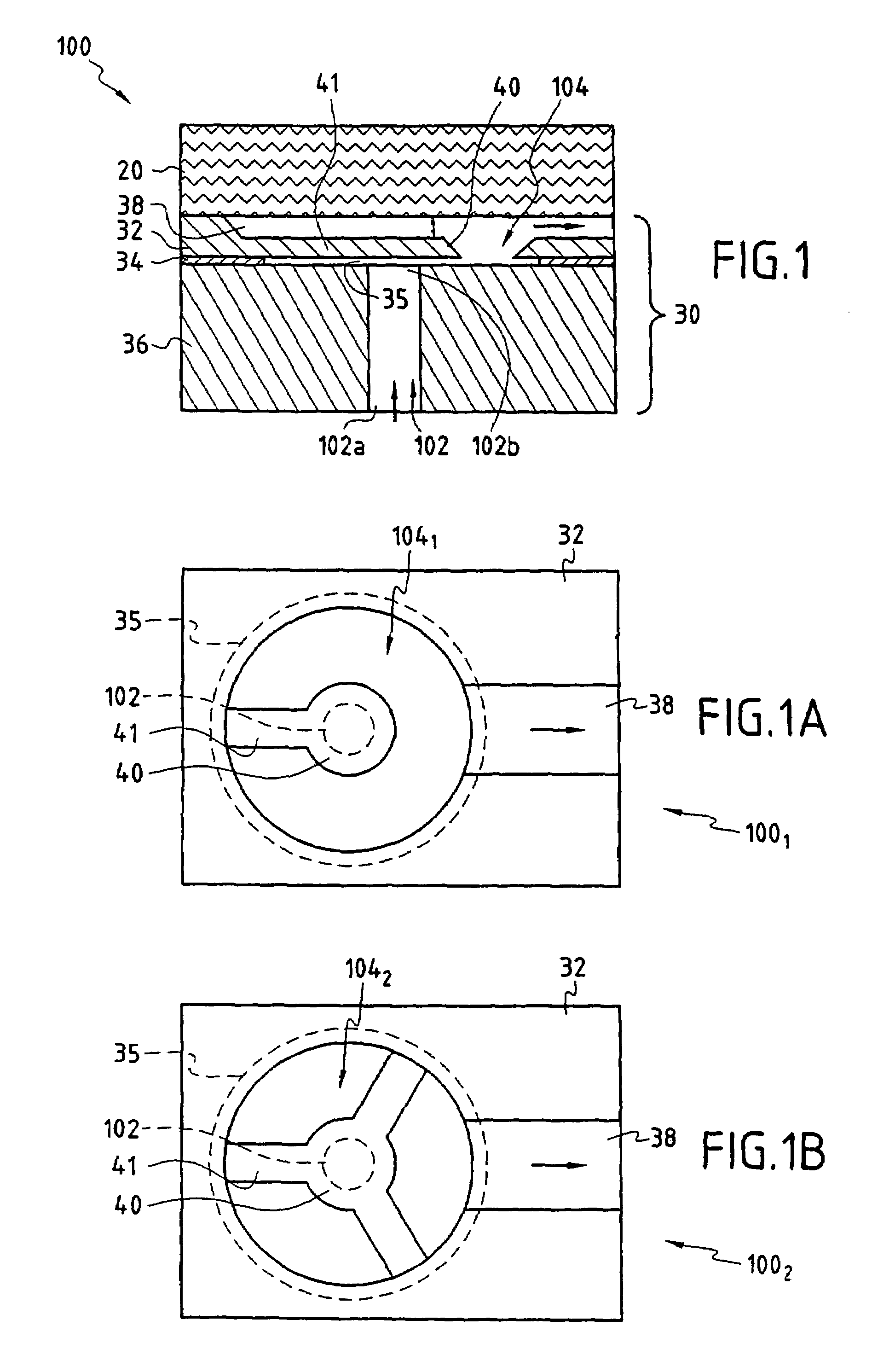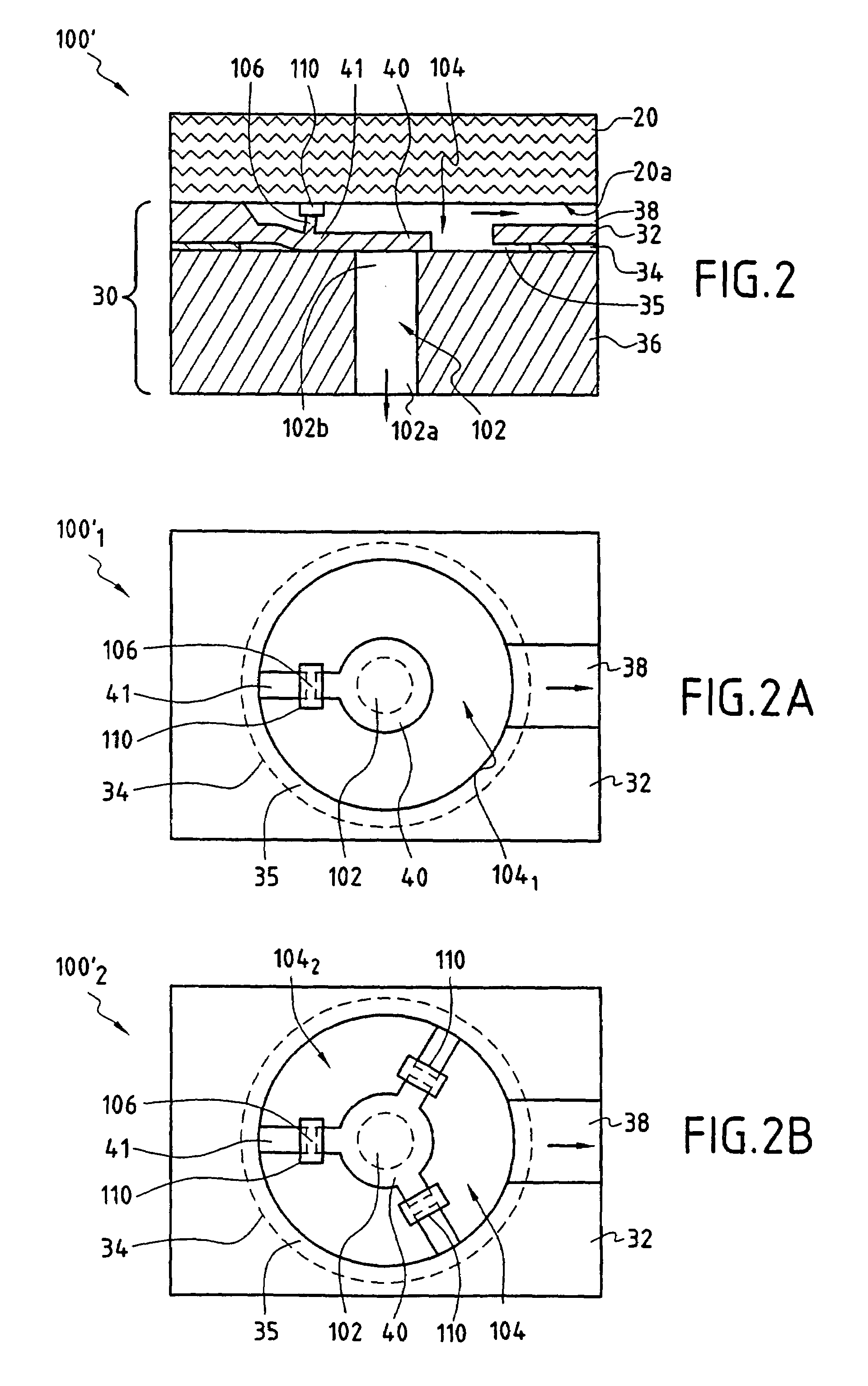Micromachined fluidic device and method for making same
a fluidic device and micromachine technology, applied in the field of micromachine, can solve the problems of degrading the compression ratio achieved by the micropump, micropump not providing its own self-priming, and complex structure of the micropump, so as to achieve reliable and minimize dead volumes
- Summary
- Abstract
- Description
- Claims
- Application Information
AI Technical Summary
Benefits of technology
Problems solved by technology
Method used
Image
Examples
second embodiment
[0079]In a second embodiment shown in FIGS. 2, 2A, and 2B, it is also possible to establish prestress placing the liquid inlet control member 100′ in its closed position when the moving member 40 is in its rest position.
[0080]For this purpose, an isolated portion 106 of the moving member 40, situated in the middle of the arm 41, is of a thickness that is equal to the initial thickness of the silicon layer 32. This portion 106 lies in register with an element 110 situated on the face 20a of the closure wafer 20 facing towards the stack, or on the free face of said portion 106.
[0081]The element 110 is preferably taken from a layer of titanium deposited on the above-specified face 20a of the closure wafer 20. This element 110 pushes the isolated portion 106 downwards and forces the moving member 40 into its closed position which then corresponds to its rest position. Nevertheless, the elasticity of the moving member 40 remains sufficient to enable it to be opened.
[0082]Thus, the portio...
third embodiment
[0095]Like in the liquid inlet control member as shown in FIGS. 3 and 3A, and likewise for the purpose of offsetting the body and the seat of the valve between the second closure wafer 20′ and the silicon support wafer, a moving portion 361 is made throughout the thickness of the support wafer 36 of the liquid inlet control member 100′″, in register with and in line with said cavity 38 and said moving member 40.
[0096]This moving portion 361 is annular (see FIGS. 4 and 4A) and it is initially defined by a first annular volume 102′″a that has no material and that has been machined throughout the thickness of the support wafer 36 in register with said zone 35 that is completely free from material in the layer of insulating material 34 and said cavity 38. Thus, the first annular volume 102′″a separates said moving portion 361 from the remainder of the support wafer 36.
[0097]This annular moving portion 361 is subsequently likewise defined by a second cylindrical volume 102′″ which is fre...
embodiment 300
[0194]The liquid outlet control member 200 shown on a larger scale in FIG. 17, and its variant embodiment 300 shown in FIG. 18 are made using the same elements as the member 100 of FIG. 1.
[0195]As can be seen in FIG. 17, the liquid outlet control member 200 presents a liquid inlet 202 in the cavity 382 and a liquid outlet duct 204 machined through the entire thickness of the silicon support stack 36 in register with the cavity 38.
[0196]The zone 352 of the silicon oxide layer 34 that is free from material is located at least in line with the liquid outlet duct 204 and extends slightly beyond it all around said duct 204.
[0197]When making the cavity 38 by machining the silicon layer 32, the moving member 40 is formed with a fraction 206 extending over substantially the entire initial thickness of the silicon layer 32 and presenting a closed outline, preferably an annular outline. This fraction 206 extends from a first end 206a facing the zone 352 of the layer of insulating material 34 ...
PUM
| Property | Measurement | Unit |
|---|---|---|
| thickness | aaaaa | aaaaa |
| thickness | aaaaa | aaaaa |
| thickness | aaaaa | aaaaa |
Abstract
Description
Claims
Application Information
 Login to View More
Login to View More - R&D
- Intellectual Property
- Life Sciences
- Materials
- Tech Scout
- Unparalleled Data Quality
- Higher Quality Content
- 60% Fewer Hallucinations
Browse by: Latest US Patents, China's latest patents, Technical Efficacy Thesaurus, Application Domain, Technology Topic, Popular Technical Reports.
© 2025 PatSnap. All rights reserved.Legal|Privacy policy|Modern Slavery Act Transparency Statement|Sitemap|About US| Contact US: help@patsnap.com



